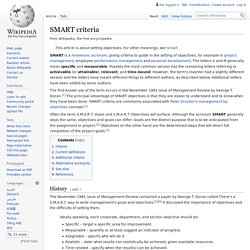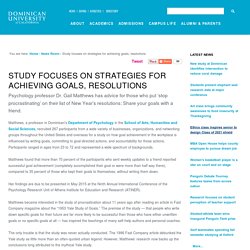

Goal Setting - Powerful Written Goals In 7 Easy Steps! — Top Achievement. By Gene Donohue The car is packed and you’re ready to go, your first ever cross-country trip.

From the White Mountains of New Hampshire to the rolling hills of San Francisco, you’re going to see it all. You put the car in gear and off you go. First stop, the Baseball Hall of Fame in Cooperstown, New York. A little while into the trip you need to check the map because you’ve reached an intersection you’re not familiar with. Stanford Medicine. Setting SMART Goals for Students and Employees. Teaching students to set goals for themselves is not a skill that is typically taught in most educational situations, yet it is a valuable life long discipline.

Most managers will agree that in order to be successful one must begin with the end in mind. Both students and employees can therefore benefit from learning how to set goals. SMART criteria. Mnemonic, giving criteria to guide in the setting of objectives SMART is a mnemonic acronym, giving criteria to guide in the setting of objectives, for example in project management, employee-performance management and personal development.

The letters S and M generally mean specific and measurable. Possibly the most common version has the remaining letters referring to achievable (or attainable), relevant, and time-bound. However, the term's inventor had a slightly different version and the letters have meant different things to different authors, as described below.
Additional letters have been added by some authors. The first-known use of the term occurs in the November 1981 issue of Management Review by George T. Often the term S.M.A.R.T. History[edit] The November 1981 issue of Management Review contained a paper by George T. S.M.A.R.T Goal setting.
What Are SMART Goals: Examples for Students and Work. Writing SMART goals is a popular objective-setting technique.

The acronym SMART stands for Specific, Measurable, Achievable, Relevant and Time-bound. We all have areas in life where we'd like to improve, whether that's getting a better job, improving our health or completing a college degree. Writing S M A R T Goals.doc. The Power of Writing Down Your Goals and Dreams. Do you write down your goals and dreams on a regular basis?

Or do you simply think about them, without actually recording them anywhere? As it turns out, your answer to this question has a HUGE impact on your odds of transforming whatever it is you desire to be, do, have or give into your reality. Why is the power of writing down goals so important? Dr. 14 Lessons From Benjamin Franklin About Getting What You Want In Life. Benjamin Franklin was a man of action.

Over his lifetime, his curiosity and passion fueled a diverse range of interests. He was a writer (often using a pseudonym), publisher, diplomat, inventor and one of the Founding Fathers of the United States. His inventions included the lightning rod, bifocals and the Franklin stove. Franklin was responsible for establishing the first public library, organizing fire fighters in Philadelphia, was one of the early supporters of mutual insurance and crossed the Atlantic eight times.
Self-development was a constant endeavor throughout his incredible life. Benjamin Franklin was clearly a man who knew how to get things done. 14 Action Inducing LessonsLess Talk, More Action “Well done is better than well said.”Talk is cheap. 5 Examples of SMART Goals for College Students. How A Simple Checklist Can Improve Learning. How A Simple Checklist Can Improve Learning.

Study focuses on strategies for achieving goals, resolutions — Dominican University of California. Matthews, a professor in Dominican's Department of Psychology in the School of Arts, Humanities and Social Sciences, recruited 267 participants from a wide variety of businesses, organizations, and networking groups throughout the United States and overseas for a study on how goal achievement in the workplace is influenced by writing goals, committing to goal-directed actions, and accountability for those actions.

Participants ranged in ages from 23 to 72 and represented a wide spectrum of backgrounds. Matthews found that more than 70 percent of the participants who sent weekly updates to a friend reported successful goal achievement (completely accomplished their goal or were more than half way there), compared to 35 percent of those who kept their goals to themselves, without writing them down. Her findings are due to be presented in May 2015 at the Ninth Annual International Conference of the Psychology Research Unit of Athens Institute for Education and Research (ATINER).
What Drives Student Motivation? Daniel Pink, a leading author in the area of changing the world of work, introduced three primary concepts as the basis for motivation: autonomy, mastery and purpose.

If you haven’t seen his YouTube video on this topic take a few minutes and check it out. When people are engaged in meaningful work, the motivation for them to do better is not for pay; they are motivated by autonomy, mastery and purpose. Pink’s book Drive is focused on the adult work place, but motivation has no age limit. What do these concepts look like when we are thinking about K-12 instructional practices? A critical question that must be asked before considering any new resources should be “Is this thinking aligned with Common Core State Standards?” So, what does it take to provide students with ongoing opportunities to engage learning using the concepts of autonomy, mastery and purpose?
Autonomy – Provide students with frequent and authentic opportunities to make choices and engage in critical thinking / design. MilestonesGuidebook. SMART Goals: Get Examples & A Free Template Now. I think you’ll agree with me when I say: SMART goals are important.

But a lot of people are left with questions about them, for example: Here’s the deal: When it comes to achieving success, one of the most important steps that you can take is setting good goals. It is also important to recognize, though, that not all goals are created equal. SMART Goals Template. Persistence.